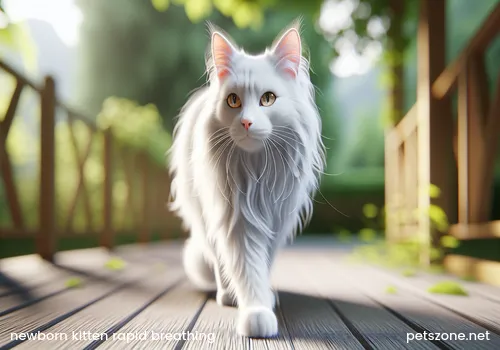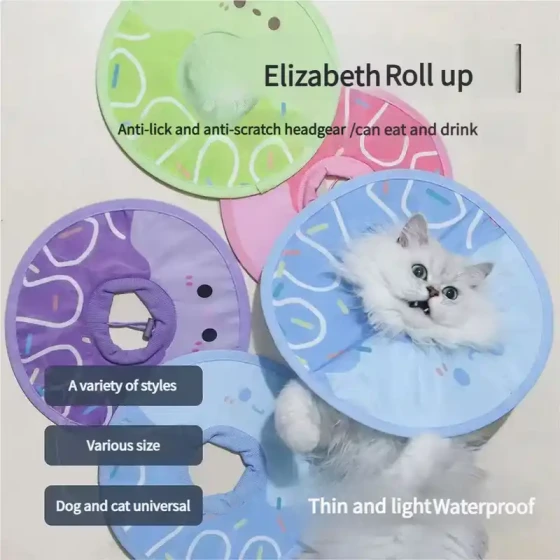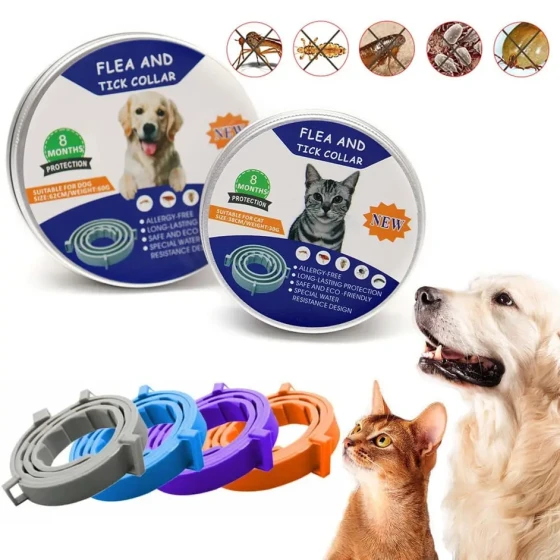Newborn Kitten Rapid Breathing_Analysis of Causes of Abnormal Breathing in Neonatal Kittens
Rapid breathing in newborn kittens is an emergency signal that requires immediate attention, usually indicating that the kitten may be facing potential health issues such as pneumonia, hypothermia, congenital defects, or severe infection. In such cases, the owner should contact a veterinarian immediately because the neonatal kitten's body functions are not fully developed, and any breathing abnormality can quickly worsen, endangering its life.
Kitten Breathing: Distinguishing Normal from Abnormal

The respiratory rate of neonatal kittens is an important indicator of their health status. Compared to adult cats, their breathing rhythm is usually faster but falls within a general normal range.
Normal Respiratory Rate:
A healthy, quiet newborn kitten breathes approximately 20-40 times per minute. After playing, excitement, or nursing, the respiratory rate may slightly increase to 50-60 breaths per minute, but this should be temporary. If the kitten's resting respiratory rate consistently exceeds 60 breaths per minute or the breathing seems labored and difficult, there may be a problem.
How to Measure Respiratory Rate:
You can count the breaths by observing the rise and fall of the kitten's chest or abdomen. One full inhale and exhale counts as one breath. It is recommended to observe when the kitten is calm and relaxed, preferably timing for one minute to get a more accurate count. Observing breathing while the kitten is asleep makes it clearer.
Signs of Abnormal Breathing:
Besides rapid breathing, the following signs may also indicate abnormal breathing:
* Mouth breathing or panting: Kittens typically do not pant like dogs unless they are extremely painful, stressed, or overheated. Mouth breathing is a serious sign of respiratory distress.
* Labored breathing: Vigorous movement of the chest or abdomen, flaring nostrils, or sounds similar to “wheezing.”
* Abnormal mucous membrane color: Whitening or purpling (cyanosis) of gums, tongue, or other mucous membranes, which is a typical sign of hypoxia.
* Abnormal posture: Stretching the neck or lying down to breathe better.
* Depressed mental state: The kitten is inactive, refuses to nurse, and is sluggish.
* Other symptoms: Accompanying cough, sneezing, nasal discharge, vomiting milk, shivering, etc.
If any of these abnormal breathing signs are found in a newborn kitten, immediate veterinary attention is essential.
Common Causes of Rapid Breathing in Neonatal Kittens
Rapid breathing in newborn kittens is not a standalone symptom but may be caused by various underlying factors. Understanding these helps better grasp the severity and assist veterinarians in treatment.
1. Respiratory Diseases
- Aspiration pneumonia: This is one of the most common and dangerous causes of rapid breathing in neonatal kittens. During nursing, if kittens inhale milk (e.g., improper feeding posture, excessive milk flow, weak sucking, or choking), milk enters the lungs and causes inflammation. Similar to coughing when choking on water, but kitten lungs are more fragile and aspiration has serious consequences.
- Bacterial or viral infections: The kitten’s immune system is immature and vulnerable to bacteria (such as mycoplasma, chlamydia) and viruses (such as feline herpesvirus, feline calicivirus). These pathogens can cause upper respiratory infections or develop into pneumonia, leading to breathing difficulties.
- Congenital pulmonary hypoplasia or malformations: A few kittens may be born with underdeveloped lungs or structural abnormalities, impairing respiratory function.
2. Systemic Diseases
- Hypothermia (Low body temperature): Newborn kittens cannot regulate body temperature independently and are very prone to hypothermia. When body temperature falls below 35°C, metabolism becomes disordered, and heart rate and breathing accelerate in an effort to generate heat. Hypothermia also weakens sucking ability, increasing the risk of aspiration pneumonia and creating a vicious cycle. This is like humans shivering in the cold; the kitten’s rapid breathing may be its body “struggling.”
- Hypoglycemia: Kittens have limited glycogen stores and are prone to hypoglycemia if fasting for long or poor digestion. Hypoglycemia affects the nervous system, causing weakness, seizures, and may disturb the respiratory center, resulting in irregular or rapid breathing.
- Septicemia/Severe infection: Severe bacterial infection of the umbilical cord or other sites, if uncontrolled, can spread bacteria and toxins into the bloodstream causing systemic inflammatory response (septicemia). Septicemia leads to multiple organ dysfunction including respiratory impairment.
- Congenital heart disease: Rarely, kittens may have congenital heart defects such as valvular abnormalities or ventricular septal defects that reduce cardiac pumping efficiency and cause pulmonary congestion, resulting in rapid breathing.
- Anemia: Severe anemia reduces blood oxygen-carrying capacity, causing hypoxia and stimulating the respiratory center to increase breathing rate compensatively.
3. Environmental Factors or Others
- Overheating: Although hypothermia is more common, excessive environmental heat can cause heatstroke in kittens, presenting with rapid breathing, elevated body temperature, irritability, etc.
- Pain or stress: Severe pain (such as trauma) or extreme stress can temporarily increase the kitten's respiratory rate. This usually accompanies loud crying or other signs of distress.
Emergency Handling and Veterinary Diagnosis
When you notice rapid breathing in a newborn kitten, the most important thing is to remain calm and immediately take the following steps:
- Keep warm: Ensure the kitten is in a warm environment but avoid overheating. Use a warm water bag (wrapped in a towel), heating pad (set to low), or your body heat to help the kitten warm up. The ideal temperature for kittens is about 29-32°C.
- Avoid force-feeding: If the kitten is having difficulty breathing, do not force milk feeding as this may cause further aspiration and worsen the condition.
- Contact a veterinarian immediately: Inform the vet about the kitten’s symptoms, when noticed, and what measures have been taken. This is the most critical step in saving the kitten’s life.
At the veterinary clinic, the vet will perform a thorough examination and diagnosis based on the kitten’s condition:
- Physical examination: Evaluating the kitten’s mental state, temperature, heart rate, respiratory sounds, and mucous membrane color.
- Imaging: Chest X-rays help identify lung inflammation, fluid, cardiac enlargement, congenital lung abnormalities, and other issues.
- Blood tests: Complete blood count and biochemical profile assess infection, anemia, blood sugar abnormalities, or organ damage.
- Fecal examination: To rule out parasitic infections.
- Other special tests: Depending on preliminary diagnosis, virus detection, bacterial cultures, cardiac ultrasound, etc., may be done.
Based on the diagnosis, the vet will formulate a treatment plan which may include:
- Oxygen therapy: Oxygen is the primary emergency treatment for severely hypoxic kittens.
- Antibiotics or antiviral medications: Target bacterial or viral infections.
- Fluid therapy: To supplement fluids and electrolytes, correct dehydration and hypoglycemia.
- Thermal support: Continue maintaining stable body temperature.
- Nebulization therapy: Helps dilute respiratory secretions and relieve airway inflammation.
- Symptomatic treatment: Such as expectorants, diuretics, etc.
- Nutritional support: Once stable, consider small frequent liquid feedings via nasogastric or gastric tube.
Frequently Asked Questions
Q1: Is rapid breathing in newborn kittens always pneumonia?
A1: Not necessarily. While pneumonia is a common cause, hypothermia, hypoglycemia, severe infection, and congenital heart disease can also cause rapid breathing. Immediate veterinary diagnosis is essential.
Q2: How to perform artificial respiration on a newborn kitten?
A2: For non-professionals, artificial respiration is not recommended. Improper operation may further damage the kitten's airway or lungs. The safest and most effective action is to take the kitten to a vet immediately.
Q3: What is the normal respiratory rate for kittens?
A3: A quiet newborn kitten usually breathes about 20-40 times per minute. A sustained rate above 60 breaths per minute or accompanied by other breathing difficulties is abnormal.
Q4: Can I give medicine to a newborn kitten with rapid breathing by myself?
A4: Absolutely not. Newborn kittens are very fragile and sensitive to medication. Self-medicating may delay treatment or cause toxicity and worsen aspiration pneumonia. All medication must be under veterinary guidance.
Conclusion
Rapid breathing in neonatal kittens is a veterinary emergency that allows no delay or hope for luck. It is a “distress signal” from the kitten’s body warning of potentially life-threatening health problems. As responsible owners, what we can do is recognize these abnormalities at the earliest moment and decisively seek professional veterinary help. Remember, for these little lives just beginning, “time is life,” and timely diagnosis and treatment are their greatest hope for healthy growth.
References:
* "Small Animal Internal Medicine"
* International Cat Care related popular science materials
* American Veterinary Medical Association related articles
* Cornell Feline Health Center articles





